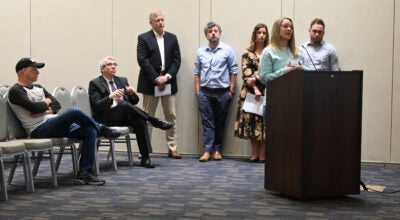Sustainable Catawba Examines Recognition Program to Encourage Green Practices
Published 12:00 am Monday, January 16, 2012
By Kathy Chaffin
The Sustainable Catawba initiative is examining ways to
encourage faculty, staff and students to make changes that will move the
college further down the path of sustainability. Research indicates that
raising awareness and providing recognition can change behaviors in ways that
will make the campus “greener.”
As part of his internship with the Center for the Environment
last semester, Environmental Education major Dan Couchenour researched green
office programs at other colleges and universities. A sophomore from Fort Mill,
S.C., he worked with Center Executive Director Dr. John Wear and Energy Corps
Fellows Craig Midgett and Michael Smith and Energy Corps Intern David Idol on
the project.
They compared green office programs at Guilford College,
Harvard University and Michigan State University. Then Dan compiled the
research to develop a presentation he delivered to the President’s Climate
Commitment Committee at Catawba in October about the benefits of starting a
green office program on campus.
The President’s Climate Commitment Committee has set a goal
to be carbon neutral by 2030. This program “is just one more step toward doing
that,” Dan said.
Catawba is already making very good efforts to become more
sustainable, he said. The green office program simply identifies steps to make
it easier. Some of them are simple, such as reducing the number of space
heaters by wearing more layers of clothing and replacing individual mini
refrigerators with regular-sized refrigerators to be shared by a group.
Dan said three mini refrigerators use the same amount of
electricity as one regular refrigerator, so it’s more energy efficient for
teachers to share one and label their food and drinks. “That’s what they do at
Guilford,” he said. Instead of requiring faculty and staff to use a communal refrigerator,
the program encourages change by rewarding those who choose the more
energy-efficient practice.
The green office programs at Guilford and Harvard are based
on certification levels. At Guilford, Dan said there are 26 areas in which
participants can gain certification, while Harvard’s program includes even
more.
Guilford certifies faculty and staff office suites,
departments and divisions based on four areas: energy, which includes lights,
office appliances and personal energy use; participation, which includes campus
involvement and office cooperation; purchasing, which includes vendor quality,
kitchen supplies and events; and solid waste, which includes recycling,
kitchenware and a trash audit.
Each office suite, department and division repeats the
three-tier certification process – from a “Seedling” to a “Tree” – at least
once year to maintain or attempt a higher certification level. “Guilford’s done
a great job of raising awareness on campus initiatives,” Dan said.
At Harvard – where administrators set a goal in 2006 to
reduce greenhouse gas emissions 30 percent by 2016 – 59 offices have been
certified so far in the green office program, which was started in January
2009. Dan said the certification process includes nine categories – energy;
events and meetings; kitchens; outreach; publications; purchasing; recycling;
transportation; and waste reduction – and a four-leaf ranking with Leaf
Four being the highest.
The university’s Green Office website offers tools and
resources for offices seeking certification, including a PowerPoint
presentation and checklist for each level and fact sheets on topics such as
green and computer power management.
Fun competitions are used as incentives toward sustainability
achievements. For example, offices completing any of the leaf checklists from
December 2009-January 2010 became eligible for a raffle prize of green office
goodies. Participants in the project receive “Green Office” decals.
Dan said Michigan State’s green office program is different
from the other two in that offices are either “Green Office” certified or
they’re not. There are no levels involved in the process.
Before conducting an audit determining whether an office
qualifies for certification, someone from the Office of Campus Sustainability
sets up a meeting with office members and explains what is required. Dan said
the university’s green certification program also includes other departments
and facilities on campus, including cafeterias and student dorm floors.
In addition to reducing the impact on the environment, other
benefits include recognition for units, departments and students at Michigan
State’s annual Earth Day event.
Dan said his presentation received a very positive response
from committee members. “The next step is figuring out which student
organization or environmental organization wants to take this on,” he said.
One thing he’d really like to see is a green certification
program such as the one at Michigan State involving dorms with incentives for
students to become more energy efficient. Dan said he hopes to continue working
with the Center staff to see a green office program implemented at Catawba.




